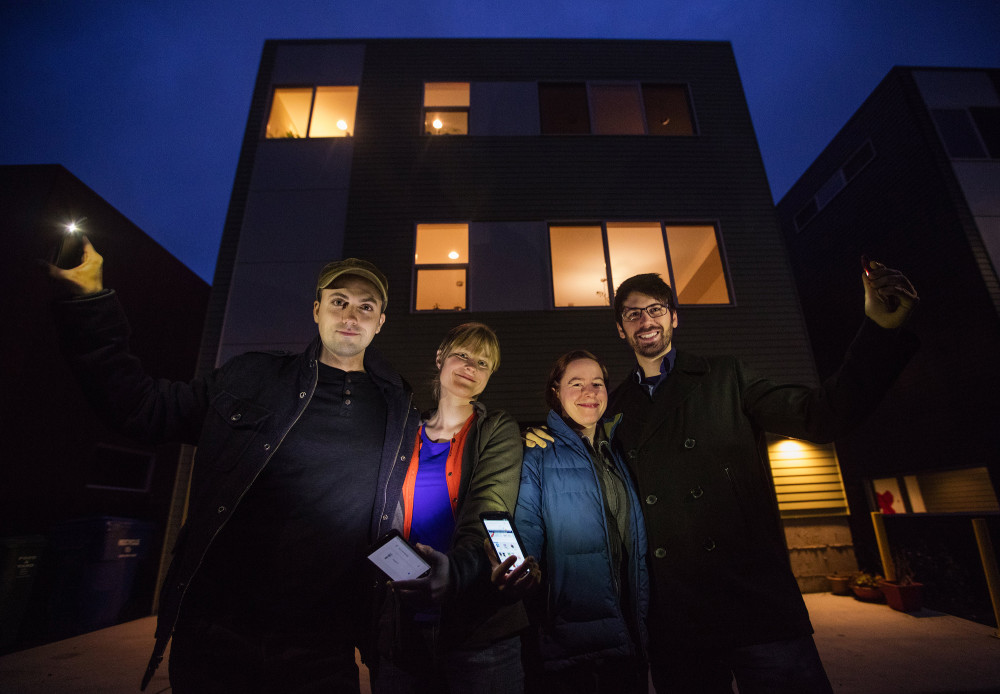By Sanjay Bhatt
The Seattle Times.
SEATTLE
A group of longtime Seattle pals is going from renting together to buying houses together, like a real-life sequel to the television sitcom “Friends.”
James Sutter, 31; his wife, Margo Arnold, 34; and another couple recently bought a new three-bedroom, three-story house in the city’s Columbia City neighborhood for $705,000.
They chose the home partly to be a short walk from four other friends, who bought a seven-bedroom house together for $719,000.
“We wanted to buy a house and grow old together,” Sutter said. “Coming home to your best friends every night, that’s what drives us. The economics are just a bonus.”
In Seattle, where the median single-family-home price hit $598,000 in November, the notion of splitting a mortgage isn’t the only thing driving younger adults to shack up together.
The 30-somethings who bought the two houses in Columbia City say they decided to buy single-family homes close together only after their efforts to develop a cohousing community for about a dozen couples ran into too many roadblocks.
“It’s really hard to build a different model of house in a city like Seattle,” said Michelle Burce, 30, who is part of the group that bought the seven-bedroom house.
Most of the 30-somethings met as students at the University of Washington, roomed together after college and wanted to create a community together.
“There are a lot of artists and scientists within the group,” said Sutter, who writes fantasy novels and role-playing games.
“We go to Burning Man together.”
Two of his fellow owners work at technology firms, the fourth at a nonprofit.
The seven-bedroom house nearby was bought by Sutter’s friend Jared Roberts, 36, and his girlfriend Michelle Burce, along with Burce’s sister, Allison, and her husband, Aaron Jacobs.
Their household consists of a chemist, an energy forecaster, a former Twitter engineer and an arts educator.
After renting houses together for years, the group wanted to buy land somewhere in the city and develop a cohousing community.
“We were planning to build basically single-family homes with less space between them, and a community house,” Roberts said.
They knew that Seattle had a few cohousing communities established more than a decade ago.
They consulted with an architect. They identified land zoned for single-family homes on 5,000-square-foot lots. They paid for a one-on-one session with city planners.
Roberts and Burce said the city planners weren’t helpful.
A city spokeswoman said the city has no guidance on cohousing because it’s not defined in the land-use code.
“A lot of it came down to the fact we couldn’t figure out if we could build what we wanted to build on a piece of property until we actually bought it,” Burce said.
Meanwhile, land prices in Seattle shot up, and their cohousing plan fell apart.
Last summer, Roberts, Burce and the Jacobses spotted a seven-bedroom, three-story house for sale just a short walk from the light-rail station in Columbia City.
“One of the biggest things that made an impact for us was having access to good public transit,” Burce said.
It’s not your typical house: Built in 1999, each floor has a full kitchen, living room and bathroom.
The first floor has its own entrance, separate from the two upper floors.
And the house sported expensive finishes like granite countertops and new appliances.
Each couple has a floor to themselves. Roberts said they rented one floor to friends, though the couples plan to use it later when they have children.
When the roof was damaged in a recent windstorm, Roberts paid for it and logged it in a spreadsheet the couples use to track and share common expenses, including the mortgage.
“We’re all on the hook,” Roberts said. “If anybody falls, we have to catch them. There’s nothing legal holding that together _ just trust.”
Soon after Roberts and his fellow owners landed a house, Sutter and his group purchased their home a half-mile away.
Sutter said he and his co-owners plan to sign a “tenancy in common” agreement to protect their legal interests in the property.
For example, they will require everyone to carry enough life insurance to cover their portion of the mortgage debt, Sutter said.
At the Sutter/Arnold/Andersen/Greenlee residence, the couples share the kitchen and living room on the main floor, and they converted the master bedroom into office space.
Each couple has a bedroom on the third floor.
“If the house had more separation between the bedrooms and we weren’t sharing a wall, that would have been better,” Sutter said. “No house is perfect.”
Chores are straightforward. Each couple clean their own bathrooms and bedrooms. Cleanup duty in common areas rotates weekly.
The two couples have lived together long enough to identify and resolve potential conflicts.
“The kitchen is always a flashpoint for problems,” Sutter said. “If somebody’s dishes are in the sink all the time, that’s an issue you have to work through.”
Both Roberts and Sutter acknowledge their lifestyle isn’t for everyone. Renting together for a long time made the transition easier.
“I wouldn’t do it without auditioning your future housemate,” Roberts said.














































































































































































































































































































































































